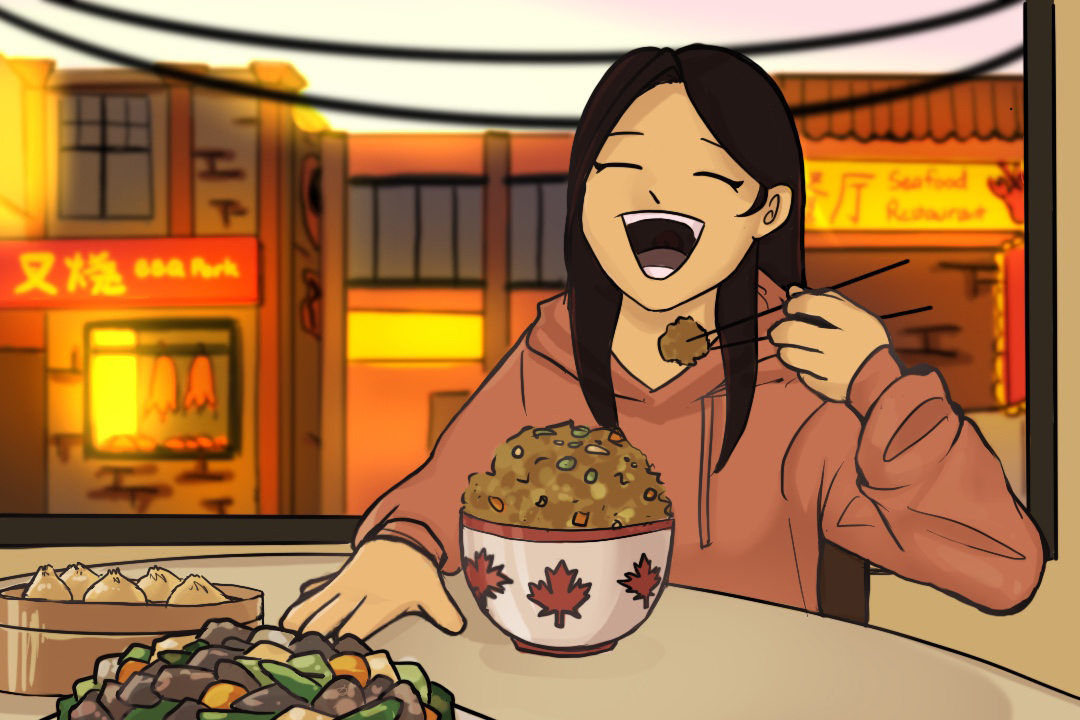If you’ve ever lived at a U of T residence, you’ve probably tasted a cafeteria’s attempt at Chinese food. Whether you liked it or not, you might have wondered, “Is this what authentic Chinese food really tastes like?”
Anyone in Canada will likely have encountered Chinese-Canadian food, or ‘Westernized’ Chinese food. Dishes like ginger beef, chop suey, and sweet and sour chicken balls are difficult to come by in China. Instead, they are a window into the lives of immigrants adapting to a foreign, often racialized experience — a quintessentially Canadian story.
Chinese-Canadian immigration
In the late nineteenth century, large numbers of poor Chinese migrants, mainly from Guangdong province, came to Canada in search of work and economic opportunity. Many of them worked on the Canadian Pacific Railway or panned for gold. Many Chinese immigrants called the western parts of North America ‘gam saan’ — which means Gold Mountain.
However, Chinese immigrants were unwelcome in Gold Mountain, and across Canada, and faced language barriers and employment discrimination. As a result, after the railroad’s completion in 1885, most immigrants settled in Chinatowns across Canada and opened their businesses.
Toronto’s Chinatown stretched south of where U of T’s St. George campus sits today, around where City Hall now stands. Like other historic Chinatowns, it was in the poorest part of the city and segregated from white communities.
What is Chinese-Canadian food?
As migrants adapted to living in Gold Mountain, so did the food they served at restaurants. Chinese-Canadian menus shifted to accommodate the palates of the majority-white Canadian population. At the same time, ingredients common in China were often difficult to find, so they relied heavily on more accessible bean sprouts, carrots, and celery.
Across Canada, Chinese-Canadian restaurants innovated. In Alberta, restaurants came up with ginger beef, which is now popular throughout the Prairies. In Newfoundland, chow mein is made with thinly shredded cabbage to resemble more conventional egg noodles. And in Thunder Bay, Chinese-Canadian restaurants serve a deep-fried rib dish called bon bons.
In recent decades, new waves of migrants have added more diversity to the Chinese-Canadian community. In the 1980s and ’90s, hundreds of thousands of middle-class and wealthy Hong Kongers came to Toronto ahead of Hong Kong’s 1997 handover to Chinese authority. More recently, newcomers, including wealthy ‘fuerdai’ — the “rich next generation” — have come from across mainland China.
Recent Chinese immigrants have brought with them a taste for ‘authentic’ regional cuisines. Chinatown West, or the Chinese-Canadian community along Spadina Avenue, now offers food from all over China, including chang fen — rice noodle rolls — hot pot, and halal Xinjiang cuisine. New restaurants and companies have a mainly Chinese clientele: they no longer need to cater to Western palates.
The ‘authenticity’ of food
Now that we have ‘real’ Chinese food, is ‘inauthentic’ Chinese-Canadian food destined for the dustbin of history?
Maybe not. A recent article in The Varsity challenged the notion of ‘authentic’ food, arguing that authenticity is deliberately produced, marketed, and subject to economic pressure. I would add that traditions are constantly invented, popularized, and spread through cultural canon. For example, ramen was brought to Japan by Chinese chefs about 100 years ago and only became mainstream in Japan in 1958.
The eternal, unchanging bulwark of tradition is a myth; authenticity is fluid, ever evolving, and flowing through the streams of immigration, culture, and politics.
Today, Chinese-Canadian food is still popular, especially outside cities with large Chinese immigrant populations like cosmopolitan Toronto. But you can still find holdouts in the GTA, comfortably existing despite the debates over authenticity.
Some of my favourite Chinese-Canadian restaurants include Sea-Hi Chop Suey Tavern in Vaughan, Ming City in York, and C’est Bon — yes, really! — in Toronto. Maybe they don’t stand up to the scrutiny of Hong Kong’s finest Cantonese food or ‘real’ Northern Chinese cuisine from Beijing. But maybe they can still be unapologetically delicious anyway. They are the heritage of the people of Gold Mountain.


